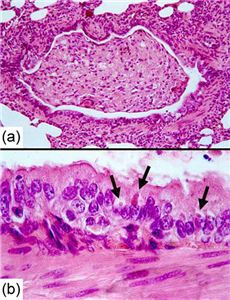Canine Distemper Virus and its Detrimental Effect on Dogs
- Eva Loftus

- Nov 22, 2020
- 3 min read
Updated: Dec 1, 2020
Canine Distemper Virus (CDV), or footpad disease, is one of the most contagious viruses to affect unvaccinated dogs and targets puppies aged 3 to 6 months old. Although CDV most commonly affects dogs, it also affects and can be spread by wolves, ferrets, and big cats. Inhaling contaminated particles (such as those from saliva) and contact with contaminated urine, feces, or vomit can easily spread CDV.

Similar to human viruses such as measles and mumps, CDV is a single-stranded RNA virus in the Paramyxoviridae family. The virus has different strains that vary in severity, and the mortality rate is highly dependent on the strain of the virus and the dog’s immune status. Even if a dog lives through the virus, there can be long lasting effects due to permanent cell death. One of the most common lasting signs is “hard pad disease”, which is where the skin around the footpad and even nose thickens. This is where CDV got its other common name, footpad disease. Cells that create tooth enamel are often targeted in this virus, which also results in the erosion of tooth enamel and consequently weaker and even eroded teeth.
Photo pictures lung lesions in an African wild dog with CDV.
CDV typically has three stages. When infected dogs begin to show symptoms, which is most often over a week after contracting the virus, they may be mistaken to have influenza. Symptoms such as sneezing, a high fever, and coughing appear because the virus first attacks the upper respiratory tract. Although this stage typically ends after your dog’s fever dies down, this is when the virus can be spread the most due to excessive sneezing and coughing.
In the second stage of CDV, the virus usually has infected the Gastrointestinal (GI) tract, causing diarrhea and lack of appetite, and the central nervous system. At this stage, the mortality rate can be up to 50%. Usually, coughs are more persistent and progress from a dry to a wet cough. If a pregnant dog is affected by CDV, they may lose their baby, or otherwise give birth to extremely weak puppies.
In the final stage, the virus begins to affect the brain. Neurological symptoms such as tremors, seizures, and partial or complete paralysis develop. Though these signs appear long after your dog is exposed to the virus—usually a few months after exposure—they are clearly detrimental to the central nervous system and bring long-lasting effects. If your dog is seizing, you must move objects away from them to avoid injury and assure you are not moving your dog to avoid getting bitten. Do not hold your dog’s mouth or force medication into their mouth. Instead, try to put light pressure on your dog’s eyes for a minute if it is safe to do so. After the episode, take your dog immediately to the hospital. There are anti-seizure medications that veterinarians can prescribe for your dog, but at times these do not work. It varies case by case, which is why discussing with a vet is the best option.
It can take up to months before the central nervous system and immune system are extremely damaged and long-lasting effects of CDV appear, so it is essential for owners to look out for symptoms of CDV. If you have recently adopted a dog that is not vaccinated or who was a stray, be very wary of these signs and if you see them, take your dog to the veterinarian as soon as possible. In order to prevent your dog from catching this fatal disease, ensure that they are vaccinated.
Citations
Canine Cognitive Dysfunction – Dog Dementia - Dog Vet-Burwood Vet Clinic.
https://www.localvet.com.au/burwoodvetclinic/CanineCognitiveDysfunction%E2%80%93DogDementia-dogvet.aspx. Accessed 11 Nov. 2020.
Guide to Canine Cognitive Dysfunction.
https://dogdementia.com/canine-cognitive-dysfunction-guide/. Accessed 11 Nov. 2020.
Prpar Mihevc, Sonja, and Gregor Majdič. “Canine Cognitive Dysfunction and Alzheimer’s
Disease - Two Facets of the Same Disease?” Frontiers in Neuroscience, vol. 13, June 2019, p. 604, doi:10.3389/fnins.2019.00604.
%20copy.png)



Comments